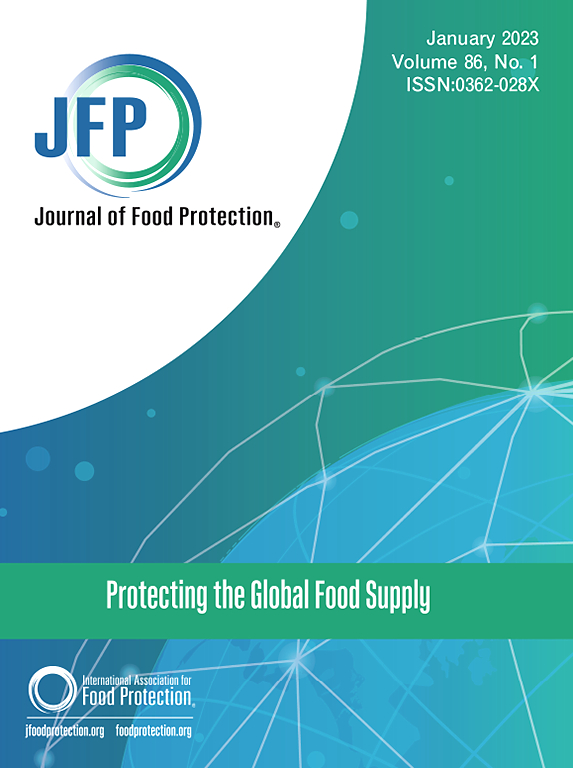陕西省黄芪重金属含量健康风险调查与评价
IF 2.8
4区 农林科学
Q3 BIOTECHNOLOGY & APPLIED MICROBIOLOGY
引用次数: 0
摘要
黄芪是一种应用广泛的中草药。本研究旨在了解陕西省黄芪的重金属含量,并评价食用黄芪对人体的潜在健康风险。在陕西省采收期间,共采集了100份黄芪标本。采用电感耦合等离子体质谱法(ICP-MS)对各样品中的镉(Cd)、铅(Pb)、镍(Ni)、总铬(Cr)、总砷(As)、铜(Cu)、钴(Co)、硒(Se)、钡(Ba)、钼(Mo)进行分析,并对元素含量进行评价。使用直接汞分析仪测量总汞(Hg)。黄芪中这些元素的平均含量差异显著。所有样品均含有可检出的Cd、Pb、Ni、Cr、As、Cu、Co、Ba、Mo等元素。部分标本中汞、硒含量均低于检出限。所有样品中每种元素的含量均低于世界卫生组织公布的法定限量。其中Cu、As、Hg、Cd、Pb的含量均符合《中华人民共和国药典2020》标准。在本研究中,食用黄芪对每种金属的目标危害商(THQ)和危害指数(HI)均小于1,表明食用陕西地区黄芪无显著的非致癌风险。每一种致癌金属的终生递增致癌风险(ILCR)和食用黄芪中所有致癌金属的总致癌风险(TCR)在成人和儿童中均低于可接受限度(ILCR和TCR=10-4)。本研究采用元素总量作为评价指标,未考虑黄芪中元素的不同形态。它也没有考虑到黄芪中重金属的溶解速度或元素的生物利用度。因此本研究采用保守评价方法。本文章由计算机程序翻译,如有差异,请以英文原文为准。
Investigation and Evaluation of the Healthy Risk of Heavy Metal Contents in Astragalus membranaceus of Shaanxi Province
Astragalus membranaceus is a widely used herbal medicine. This study was conducted to understand the heavy metal contents of A. membranaceus in Shaanxi Province of China and to evaluate the potential human health risks associated with its consumption. A total of 100 samples of A. membranaceus were collected during the harvest period in Shaanxi province. Inductively coupled plasma mass spectrometry (ICP-MS) was used to analyze cadmium (Cd), lead (Pb), nickel (Ni), total chromium (Cr), total arsenic (As), copper (Cu), cobalt (Co), selenium (Se), barium (Ba), molybdenum (Mo) in each sample, and the elements’ contents were evaluated. Total mercury(Hg) was measured using a direct mercury analyzer. The mean content of these elements in A. membranaceus was significantly different. All samples contained detectable concentrations of Cd, Pb, Ni, Cr, As, Cu, Co, Ba, and Mo. The concentrations of Hg and Se in certain specimens of A. membranaceus were found to be below the limits of detection. The contents of each element in all samples were lower than the legal limit published by the World Health Organization. Additionally, the contents of Cu, As, Hg, Cd, and Pb all conformed to the standards of the Pharmacopoeia of the People's Republic of China 2020. In this study, the target hazard quotient (THQ) for each metal and the hazard index (HI) through consumption of A. membranaceus were less than 1, indicating no significant noncarcinogenic risk associated with the consumption of A. membranaceus from the Shaanxi areas of China. The incremental lifetime cancer risk (ILCR) of each carcinogenic metal and the total carcinogenic risk (TCR) of all carcinogenic metals from A. membranaceus consumption for both adults and children were lower than the acceptable limit (ILCR and TCR = 10−4). This study used the total amount of elements for evaluation and did not consider the different forms of the elements in A. membranaceus. It also did not take into account the dissolution rate of heavy metals from A. membranaceus or the bioavailability of the elements. So this study employed a conservative evaluation method.
求助全文
通过发布文献求助,成功后即可免费获取论文全文。
去求助
来源期刊

Journal of food protection
工程技术-生物工程与应用微生物
CiteScore
4.20
自引率
5.00%
发文量
296
审稿时长
2.5 months
期刊介绍:
The Journal of Food Protection® (JFP) is an international, monthly scientific journal in the English language published by the International Association for Food Protection (IAFP). JFP publishes research and review articles on all aspects of food protection and safety. Major emphases of JFP are placed on studies dealing with:
Tracking, detecting (including traditional, molecular, and real-time), inactivating, and controlling food-related hazards, including microorganisms (including antibiotic resistance), microbial (mycotoxins, seafood toxins) and non-microbial toxins (heavy metals, pesticides, veterinary drug residues, migrants from food packaging, and processing contaminants), allergens and pests (insects, rodents) in human food, pet food and animal feed throughout the food chain;
Microbiological food quality and traditional/novel methods to assay microbiological food quality;
Prevention of food-related hazards and food spoilage through food preservatives and thermal/non-thermal processes, including process validation;
Food fermentations and food-related probiotics;
Safe food handling practices during pre-harvest, harvest, post-harvest, distribution and consumption, including food safety education for retailers, foodservice, and consumers;
Risk assessments for food-related hazards;
Economic impact of food-related hazards, foodborne illness, food loss, food spoilage, and adulterated foods;
Food fraud, food authentication, food defense, and foodborne disease outbreak investigations.
 求助内容:
求助内容: 应助结果提醒方式:
应助结果提醒方式:


